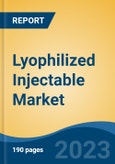Speak directly to the analyst to clarify any post sales queries you may have.
10% Free customizationThis report comes with 10% free customization, enabling you to add data that meets your specific business needs.
Increasing R&D activities, global collaborations between pharmaceutical giants and contract manufacturing organizations, and the rising demand for long-acting and stable drug formulations are driving market growth. Notably, industry players are expanding R&D capabilities, as seen in initiatives like Pfizer’s development hub in India, which focuses on APIs and finished dosage forms, including lyophilized products. As biologics and personalized therapies continue to gain momentum, the adoption of lyophilized injectables is expected to accelerate across the healthcare ecosystem.
Key Market Drivers
Increasing Demand for Biologics and Specialty Drugs
The rising demand for biologics and specialty medications is a major factor boosting the growth of the lyophilized injectable market. Biologics have gained prominence due to their targeted effectiveness in treating chronic and complex conditions such as cancer, autoimmune diseases, and rare disorders. Unlike conventional small molecule drugs, biologics require specific storage and delivery conditions, making lyophilization an ideal method for maintaining their structural and therapeutic integrity. As pharmaceutical firms expand their biologics portfolios, lyophilized formulations are increasingly preferred to ensure long-term stability and patient safety. The demand for individualized treatment approaches, coupled with the need for advanced drug delivery systems, continues to push lyophilized technologies into the spotlight. Healthcare providers are also prioritizing injectables that combine extended shelf life with minimal preparation time, reinforcing the need for robust and reliable freeze-dried drug formats.Key Market Challenges
High Development and Manufacturing Costs
One of the major challenges impeding market expansion is the high cost associated with developing and manufacturing lyophilized injectable products. The lyophilization process involves sophisticated technology, including specialized equipment and rigorous validation protocols, all of which demand significant capital investment. Moreover, maintaining stringent quality control and regulatory compliance adds to the financial burden. These elevated production expenses often translate into higher product prices, potentially limiting access to such therapies in price-sensitive markets. Additionally, small- and mid-sized pharmaceutical firms may hesitate to invest in lyophilized drug development due to the associated operational and financial risks, which can slow the pace of innovation and new product introductions.Key Market Trends
Expansion of Biologics and Biosimilars
A key trend shaping the lyophilized injectable market is the rapid expansion of biologics and biosimilars. Biologic therapies - including monoclonal antibodies, therapeutic proteins, and vaccines - often require lyophilization to maintain efficacy throughout their lifecycle. As global demand for these therapies grows, pharmaceutical manufacturers are increasingly focused on enhancing lyophilization processes to meet regulatory standards and market expectations. Biosimilars, which offer cost-effective alternatives to branded biologics, are also contributing to the demand for freeze-dried injectable formulations. This trend is stimulating innovation in lyophilization equipment, packaging, and formulation techniques, resulting in greater product availability, improved patient compliance, and increased competitiveness across global markets.Key Players Profiled in this Lyophilized Injectable Market Report
- B. Braun Melsungen AG
- Baxter International Inc.
- Becton, Dickinson and Company
- Schott AG
- Aristopharma Ltd.
- Vetter Pharma GmbH
- Jubilant HollisterStier LLC
- Bristol Myers Squibb
- F. Hoffmann-La Roche Ltd
- Novo Nordisk A/S
Report Scope:
In this report, the Global Lyophilized Injectable Market has been segmented into the following categories, in addition to the industry trends which have also been detailed below:Lyophilized Injectable Market, by Packaging:
- Single-Use Vials
- Point-Of-Care Reconstitution
- Specialty Packaging
Lyophilized Injectable Market, by Delivery:
- Prefilled Diluent Syringes
- Proprietary Reconstitution Devices
- Single-Step Devices
- Multi-Step Devices
Lyophilized Injectable Market, by Indication:
- Autoimmune Diseases
- Infectious Diseases
- Metabolic Conditions
- Others
Lyophilized Injectable Market, by End-User:
- Hospital Pharmacy
- Retail Pharmacy
- Others
Lyophilized Injectable Market, by Region:
- North America
- United States
- Canada
- Mexico
- Europe
- France
- United Kingdom
- Italy
- Germany
- Spain
- Asia-Pacific
- China
- India
- Japan
- Australia
- South Korea
- South America
- Brazil
- Argentina
- Colombia
- Middle East & Africa
- South Africa
- Saudi Arabia
- UAE
Competitive Landscape
Company Profiles: Detailed analysis of the major companies present in the Global Lyophilized Injectable Market.Available Customizations:
With the given market data, the publisher offers customizations according to a company's specific needs. The following customization options are available for the report.Company Information
- Detailed analysis and profiling of additional market players (up to five).
This product will be delivered within 1-3 business days.
Table of Contents
Companies Mentioned
The leading companies profiled in this Lyophilized Injectable market report include:- B. Braun Melsungen AG
- Baxter International Inc.
- Becton, Dickinson and Company
- Schott AG
- Aristopharma Ltd.
- Vetter Pharma GmbH
- Jubilant HollisterStier LLC
- Bristol Myers Squibb
- F. Hoffmann-La Roche Ltd
- Novo Nordisk A/S
Table Information
| Report Attribute | Details |
|---|---|
| No. of Pages | 190 |
| Published | May 2025 |
| Forecast Period | 2024 - 2030 |
| Estimated Market Value ( USD | $ 3.14 Billion |
| Forecasted Market Value ( USD | $ 5.41 Billion |
| Compound Annual Growth Rate | 9.4% |
| Regions Covered | Global |
| No. of Companies Mentioned | 11 |









